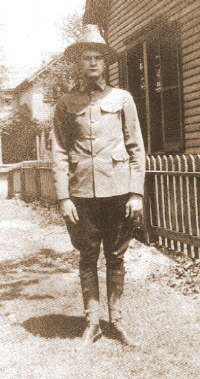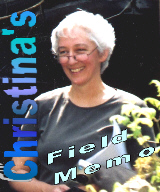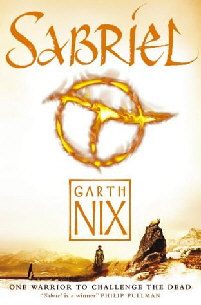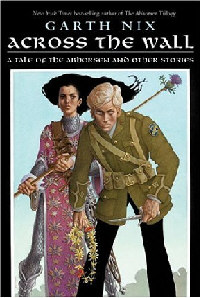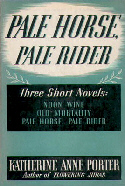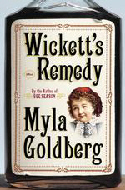
TRENCH REPORT: Battlefield Travelers have lots of opportunities coming up. If you missed the news previously, there are two US-based, 10-day group tours of the WWI battlefields planned for the Spring. I'll be leading one in May for Valor Tours (email) and my friends and fellow GWS/WFA members Frank Jordan & Tom Gudmestad the second in June. (email). The WFA-USA has also asked us to announce their biennial tour covering Mons, the Argonne & St. Mihiel is scheduled for May 2007 (email). Just email the appropriate tour leaders for full itineraries. . .The WFA-USA has chosen not to award a student essay prize this year. The contest for next year, however, is open. (entry details) MH
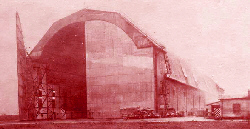
Zeppelin Shed at Trier
This Month's Internet Feature
AJP Taylor
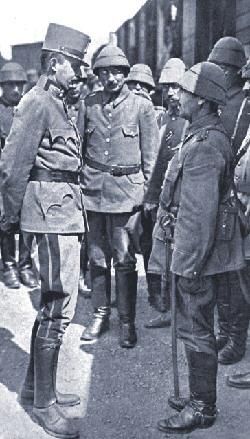
Future Austrian Emperor Karl
(And Future Candidate for Sainthood)
With Turkish Troops in Galicia
The US National Gallery of Art's show Dada-- about the 1916-1924 international protest movement against World War I's horrors--has just opened and an accompanying film series will begin in April. (link)
. . .Good article on the disillusionment of German Expressionists who served in the war at: (link). . .GWS author Tom Phelan--whose novel The Canal Bridge has received boffo reviews--has a speaking tour scheduled on the East Coast during the spring on Ireland's Forgotten WWI Soldiers (full schedule). . .Professor Jim Cooke recommends a new publication: David L. Snead's (ed.), George Browne, An American Soldier in World War I, Lincoln
(University of Nebraska Press, 2006). Browne was a soldier in the 117th
Engineer Regiment of the 42nd Rainbow Division. . .Attention Leathernecks & Leatherneck Lovers! If you haven't discovered it yet, Bradley Omanson's Scuttlebutt and Small Chow website is an endlessly fascinating source of information on the Marines. (link)
New at the Websites of the Great War Society and Our Friends
Click on Title to Access
|
At Great War Society Sites
At the WFA-USA
2006 WFA-USA National Seminar
Aurora, Colorado - May 19-21
Full Program |
|

Over 70,000 American soldiers were killed or wounded by gas in WWI. While only 1,400 were reported as dying in theatre due to gassing, thousands of these men died because their weakened lungs were susceptible to the influenza and many others who survived the war died prematurely due to respiratory disorders.
From Chemical Warfare in World War I: The American Experience, 1917 - 1918
|

Au Revoir' "Literary Stuff"
Our literary section has outgrown it's regular position here on Page One of the Trip-Wire. Look for it below, where--under its new moniker Behind the Literary Lines--it will share Page Three with Andy's Nickelodeon and Esther's Base Details. This month's literary feature is a Double-Double. Len Shurtleff reviews the two most famous novels inspired by the Battle of Verdun and Donna Cunningham discusses two novels on the Spanish Influenza Pandemic.
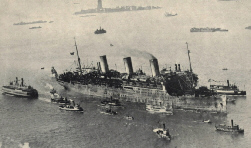
USS Leviathan Arrives NY, March 6, 1919
Carrying 10,000 Members 27th Division
GREAT WAR 2006 EVENT CALENDAR
|
Verdun and Somme
90th Commemorative Events
Comprehensive Double Calendar
Scheduled Throughout 2006 (link)
|
Pancho Villa
Columbus, NM Raid
90th Commemorative Events
Appearances by Pershing's Doughboys at Columbus and Pancho Villa State Park.
March 9 & 11, 2006 (email Columbus Historical Society)
|
WFA-Pacific Branch Spring Seminar
Bay Street Armoury, Officer's Mess
At Victoria BC
March 10-12 (link)
|
WFA-USA East Coast Branch Seminar
Baltimore, MD
April 1 (link)
|
The First World War and
Popular Culture
Newcastle Inst. for the Arts & Social Sciences
March 31 - Apr. 2 (link)
|
WFA-USA National Seminar
Aurora, Colorado
May 19-21 (link)
|
WFA-USA Florida Gulf Chapter Seminar
Hilton Garden Inn, Tampa North
August 16 (link)
|
Send additions/corrections:
Email Response
|

Memorable Event
|
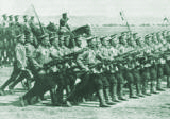
March 18-21, 1916
Russian Defeat at
Battle of Lake Naroch
Click on Image for More Information
|
|

Tread softly here --
Go reverently and slow, --
Yea, let your soul go down upon its knees, --
And with bowed head and heart abased --
Strive hard to grasp the future gain in this sore loss.
For not one foot of this dank sod --
But drank its surfeit of the blood of gallant men --
Who for their Faith, their Hope, for Life and Liberty --
Here made the sacrifice.
Here gave their lives, and right willingly for you and me.
Inscription
Newfoundland Park, Somme Battlefield
|
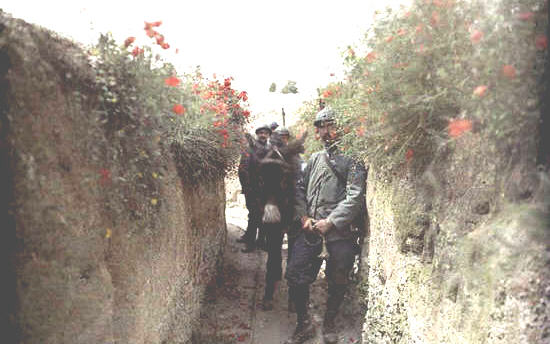
Red Poppies Growing in French Communications Trench
|
We have received announcements of the passing of two more World War I veterans:
- Fernand Gilson, 107
- Poilu in the Great War; Resistance fighter in WWII.
- Nicholas Swarbrick, 107
- Last surviving British Merchant Seaman.
(link)
|
|
Page Two
|
 |
Corporal Vernon E. Kniptash
Contributed by Major General Thomas Jones
|
Vernon E. Kniptash served with the Headquarters Company of the 150th Field Artillery with the 42nd Rainbow Division in the American Expeditionary Force. He had been born in Terra Haute, Indiana and enlisted in the state National Guard artillery. He may have served with the regiment on the Mexican Border prior to the war. After being added to the Rainbow division the unit was redesignated the 150th Field Artillery and participated in all six major campaigns of the Division in Europe. Corporal Kniptash was discharged in May 1919 at Camp Zachery Taylor, Kentucky.
Like many other soldiers, Vernon kept a diary and also made many sketches to document his service in France. The diary has been edited and annotated for publication by a history professor at Ball State University in Muncie, but a publisher has not yet been found for it.
A draftsman and an artist, he worked in the architectural and engineering fields in Indianapolis. Eventually, he received his Professional Engineer's license without having gone to college. Such things were once possible in the Hoosier State.
|
Verdun
March 1916:
Mort Homme &
Hill 304 |
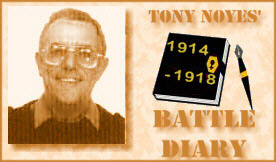
|
The Somme
Spring 1916
The Pals
|
On the left bank of the Meuse are three lines of hills running from east to west towards Vauquois and the Argonne Forest, their eastern foothills lapping the Meuse river.
On 21st February, the northernmost hills held the two opposing front lines, the next line of hills made up the separate heights of Mort Homme and Hill 304 which were in French hands, and the southernmost hills held a range of French forts roughly in line with those on the east bank.
The German assault on the east bank had reached Fort Douaumont on 25th February, but the front lines on the west bank of the river had not moved as per Falkenhayn's original instructions, and were some 6 kilometers back behind the new, eastern, front lines. It was a simple matter for Petain to order all the French guns on the west bank to "turn right" and fire into the back of the German forces moving southwards up to the forts across the river. This they did with commendable accuracy, since, in many cases their targets were in plain sight, and German losses mounted appreciably in the last days of February and the early days of March.
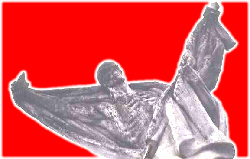
Evocative Mort Homme Monument
It was obvious that these guns needed to be eliminated but they were hidden behind the west bank forts on the southernmost ridge. The answer was simple, the German forces would advance to take the hill of Mort Homme as a first step to neutralizing the artillery on the southernmost ridge. On 6th March the first assaults commenced against Mort Homme. They failed. Not surprisingly, they had come under fire from the adjacent Hill 304 and from an excellent, rapidly formed French defence on Mort Homme.
The answer was simple; attack Hill 304.
For the entire months of March and April the Germans repeatedly stormed the wracked hillsides. The weather turned foul with heavy rain and the chalky soil, already turned to powder by the monstrous shelling, turned to liquid plaster. Such trenches as could be scraped in this rubbish collapsed or flooded, weapons jammed utterly, and men drowned here on top of the hills.
(cont. on right)
|
August and September 1914 had been a time of great excitement, and of an outpouring of patriotism for the British. All young men wanted to be in on these great events. Town Halls, drill halls, schools and large public buildings were opened as recruiting centres and queues of young men were waiting before dawn for the doors to open.
To them it was the door to adventure, to the older men down on their luck, it meant three meals a day, and a bed at night. It might even mean escape from the absolute drudgery of life in the poor streets of the mighty industrial towns.
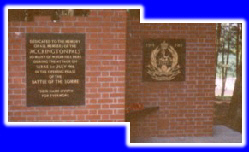
Accrington Pals Memorial, Somme
Under the watchful eyes and pointing finger of Kitchener, and for whatever reason and at whatever age, nearly 1,000,000 men surged to join The Colours. Those who were aged under 19 and so admitted to the resplendent sergeant on the door, were invited to go for a walk and "Come back when you're older, Sonny!" Those who were too short were invited to go away, buy a newspaper, stuff it in your shoes and come back tomorrow when you're taller?
Often a complete body of men joined up en masse and thus there came to be whole battalions made up of men from the same town or even the same employer. For example, there were the "Newcastle Railway Pals", the "2nd Glasgow Boys Brigade" and the "Leeds Pals".
But that was all in the future; now they had to learn to be soldiers! In the Spring the many, many, new Army Pals Battalions--all of them-- were preparing to find their various fates on the fields of the rolling Somme countryside.
(Verdun cont.)
The landscape was an absolute wilderness of featureless shell holes and the night time reliefs of men on both sides were appalling since nobody knew where their own men were in this shell blasted shambles.
|
If you would like to visit these fields of memory for a detailed tour, please email Tony Noyes or Christina Holstein to discuss your requirements without obligation.
|
|
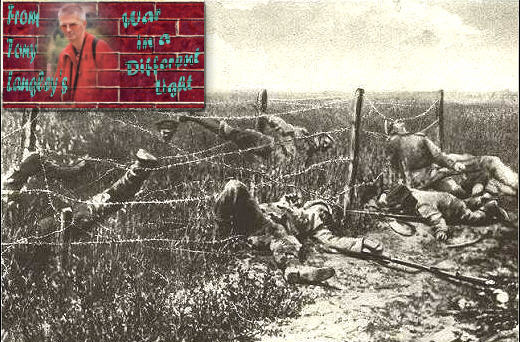
German Magazine Depiction of the War from Weltkrieg in Rauhen Wirklichkeit
Click Here to Visit War in a Different Light
|
90th Anniversary Ceremonies
At Verdun
By Christina Holstein
Tuesday, 21 February 2006, was the 90th anniversary of the start of the Battle of Verdun. It was marked by various events that ranged from a historical evocation of the battle for Caures Wood and the death of the well-known Lt. Colonel Driant, to a memorial walk and a concert in Verdun Cathedral given by Barbara Hendricks. Despite bitter cold, all events were very well attended. The historical evocation at Caures Wood, which began at 6.30 am, featured French and German re-enactors and readings from soldiersí letters. It was followed by a two-mile torch lit walk from the site of Lt. Col. Driantís command post to the village of Beaumont, one of the nine villages at Verdun that were destroyed in the battle and have never been rebuilt. Later in the day the French Secretary for Veteransí Affairs and other civic and military dignitaries attended a wreath-laying ceremony in the city of Verdun. The Barbara Hendricks concert in the evening of 21 February was, of course, a sellout.
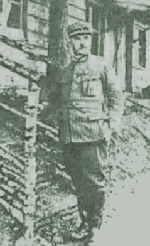
Driant at His P.C. |
On Sunday, 19 February, a local association organized the fifth memorial walk from the village of Azannes, which is north of Verdun, to Lt. Col. Driantís command post. On 22 February 1916 Azannes was the jump-off point for the famous German 24th Brandenburger Infantry Regiment, which took Fort Douaumont on 25 February 1916. This year the four-mile walk included a group of re-enactors in French and German uniforms. The official commemoration ceremony for Lt. Col. Driant and the two battalions of Chasseurs that defended Caures Wood was held during the afternoon of 19 February. This year it was attended by various members of the Driant family. After the official ceremony was over, a descendant of one of Driantís Chasseurs who was killed on 21 February 1916 quietly added his own personal bouquet to the many civil and military wreaths on the monument. It was a poignant reminder of the personal loss still felt by so many families.
Later in the week Camp Elizabeth, a reconstructed German camp situated in the woods to the north of Verdun, was open to the public, together with a small exhibition of uniforms, personal equipment and photographs. It will be open again during May.
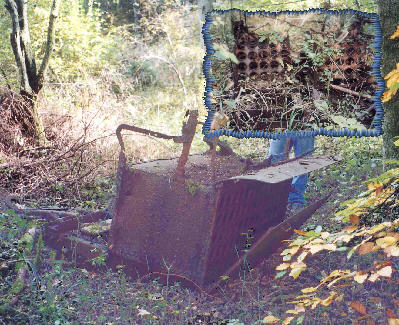
French 75 Gun Limber [Detail Inserted], Verdun Battlefield
Further events planned for later in the year include a series of concerts in the cathedral, plays and films. President Chirac of France and Chancellor Merkel of Germany will attend the official commemoration ceremony at Verdun on 25 June 2006. On that occasion, President Chirac will inaugurate the new Islamic Memorial, which is being constructed close to the Ossuary. It takes the form of a courtyard, a colonnade and a small, white, domed building.
|
World War I Headlines
in the
21st Century
|
|
|
Page Three
|
 |
I. Two on Verdun
By Len Shurtleff
|
In this 90th anniversary year of the Battle of Verdun perhaps the most massive and best-remembered of the Western Front battles of World War I, it is fitting to remember two of the best works of fiction written about that battle:
- Education before Verdun (Eeziehung vor Verdun)
- by Arnold Zweig (1935)
- Verdun
- by Jules Romains (1937)
Both these novels are part of larger series. Education before Verdun is part of a trilogy including The Case of Sergeant Grischa (1927) and The Crowning of a King (1937). Romains' work is part of the massive 27 volume cycle Men of Goodwill (Les Hommes de Bonne Volunté) an intricate and panoramic view of French life from 1908 to 1933. Verdun is actually two novels: The Prelude to Battle and The Battle.
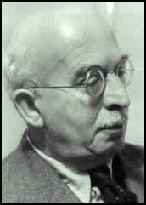
Arnold Zweig |
Zweig and Romains (Louis Farigoule) were contemporaries born in 1887 and 1885 respectively, but otherwise very different men. Zweig was a Jew born in what is now Poland. He was a WWI veteran of both fronts, fought at Verdun, was after the war a politically active Zionist and socialist who was denationalized by the Nazis, fled to Israel and returned to live in the German Democratic Republic (GDR) after World War II . There, he joined the Communist Party and became a parliamentarian. Romains was a brilliant, polished Parisian philosopher, poet, playwright and member of the French Academy, one of the immortals of French literature whose works are considered classics. He was not a veteran of the 1914-18 conflict.
Still, the two books are very similar in their non-polemical, but far from detached, approach to men at war. Both take a top to bottom look at war through characters of varied social and military rank and background involved in a life and death struggle. Most of Zwieg's protagonists are enlisted me and noncommissioned officers. Romains' protagonists range from private soldiers to generals to politicians and civilians of varying social strata and occupation, a cross section of French society. Both draw their characters deftly and in several dimensions. Though their focus is relatively narrow (the battle) their narratives encompass a range of emotions, social and political tendencies and philosophies.
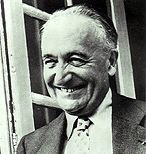
Jules Romains |
Neither book is an easy read. Neither has the relatively simple plot line of Remarques' All Quiet on the Western Front, but both share Remarques' sympathy for the sufferings of the common front line soldier. Both require concentration by the reader to comprehend the often subtle interplay of emotion, philosophical outlook and politics of the characters and the authors' use of them to illuminate a major European upheaval whose legacy still reverberates.
You can purchase English translations of both books. Verdun by Jules Romains is in print in paperback from Trafalgar Square publishers. Education before Verdun by Arnold Zweig is available from many used book sellers. His The Case of Sergeant Grischa is still in print from Overlook and several other publishers in trade paperback.
|
|
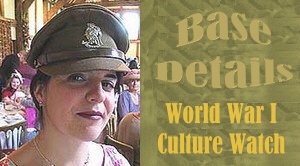 |
The War Parable:
The First World War as a 'Generic' Literary Event, Part II.
By Dr. Esther MacCallum-Stewart
|
In my last article I discussed the war as a secondary event in a text and pointed at some of the more detrimental effects this can have on popular perceptions of the war. This month. I look at a text which takes these ideas and uses them in a constructive manner. Garth Nix's Old Kingdom Trilogy: (Sabriel: 2001 Lireal: 2001, Abhorsen: 2004, plus a book of short stories about the characters, Across the Wall: 2005) is not about the war at all - it is a young adult fantasy text. However, it clearly contains a series of images that connote the war. These books demonstrate more neutral ways of representing WWI and also show how it has become an interesting signifier for 'types' of conflict.
Are these books really about the war? Well, looking at it, the answer is no. The war comes as a secondary element of atmosphere, and apparently has little to do with the central plot. It is merely a good, evocative setting within the text and is handled with an understated confidence that does not need to pull the emotive strings of war, suffering and futility. Simply by engaging a landscape of war, Nix foreshadows what is to come, but also presents cultural 'givens' about WWI which suggest how fully it has integrated itself into the popular psyche.
The plot is relatively simple: Sabriel has been brought up in the unmagical land of Ancelstierre, recognisable as a hybrid version of 1910s and 1940s wartime Britain. She attends a boarding school in a world where automobiles, rifles and technology all exist but are explicitly historicised and appear more primitive than our 'modern' inventions. Ancelstierre is however bordered by another land: the Old Kingdom. This place is very different; medieval in flavour and imbued with magic. These magical qualities cause technology to stop working, problematic because the Old Kingdom is also a place where the Dead rise and attack the inhabitants. To protect Ancelstierre, therefore, a magical Wall divides the two realms, and it is this boundary which Nix uses to engage ideas about WW1.
The Wall is written as a conglomerate of First and Cold War locations; the Wall itself suggests the Berlin Wall, but the retrograde technology and mentality of the soldiers manning the wall clearly depicts ideals about WW1. In this place trenches defend the inhabitants and flares, dugouts and rifles with bayonets are the most modern form of progress that can be used as defence. Officers are competent sergeants or 'shiny-bum' junior officers behind the lines. Ultimately, of course, in the third book of the series (Abhorsen), the Dead attack the Wall en masse. The soldiers and heroes of the books deal with this accordingly, and of course, many of the nameless soldiers are killed in the ensuring combat.
What is interesting about this is the way that tropes about the war are used casually but without recourse to overemotive labelling. The soldiers do their jobs, and are indeed killed in large numbers. The central characters feel genuine regret for this, but the reader also knows that subconsciously, this was bound to happen as the ideals of the war - many men dying with inadequate technology, stoic endurance despite terrible odds, have been suggested merely through using the ideas of a country at war using WW1 values and implements. Nix has enough subtlety not to dwell on this - the soldiers are after all, simply a background to the main plot of the story, but at the same time the reader has picked up on wartime values, as well as Nix trusting (or expecting) a certain degree of background knowledge about 'what the war was supposed to be like'. The fact that he does this without endless (and unnecessary) recourse to ideas about 'the pity of war' or 'the futility of so many deaths' - in fact the soldiers play a useful part in saving Ancelstierre, despite their loss of life - is testimony to the ways that values about the war can be used productively, instead of the tired symbolism of horror and blood.
Dr. Esther MacCallum-Stewart is a researcher at the University of Sussex and runs our favorite First World War weblog Break of Day in the Trenches.
Click on the icon below to visit her site.

|
|
 |
II. Two on the Spanish Influenza Pandemic
By Donna Cunninglham
|
Recent focus on the bird flu has brought renewed attention to the influenza epidemic of 1918-1919. Two works of fiction, one classic story and one recent novel, have at their core the flu and its effects. Pale Horse, Pale Rider by Katherine Anne Porter was originally published in 1939 (ISBN 0-15-170755-3). Wickett's Remedy by Myla Goldberg was published in 2005 (ISBN 0-385-51324-0). Both novels are the stories of women caught up in the events of the Great War.
Miranda, the main character in Pale Horse, Pale Rider works for a newspaper. Against a backdrop of war bond drives, young men on their way to the front, and civilians trying to do their patriotic duty, Miranda carries on a friendship with a soldier bound for the front. As the short novel unfolds, Miranda becomes sick with the flu. She recovers, only to discover that her soldier friend who had nursed her in her sickness had succumbed from the disease upon his return to camp. Katherine Anne Porter's writing is simple, and the short novel is a powerful description of the era of World War I.
|
Wickett's Remedy by Myla Goldberg covers similar events. Lydia, an Irish American shopgirl in South Boston loses several members of her family to the influenza epidemic. In her grief, she volunteers to assist with medical experiments being performed on Gallups Island off the coast of Boston. The project involves attempting to inflict healthy soldier volunteers with the flu to study its cause. While Pale Horse, Pale Rider is a direct narrative, Wickett's Remedy is a more complicated story, with parallel plots and subplots. Comments in the margins, presumably from people who are deceased elaborate the story.
|
Both novels vividly recount the effects on the home front of the war and the flu epidemic. Katherine Anne Porter's work achieves this effect through direct and powerful prose. Myla Goldberg weaves a quilt of people and events. Both books are well worth reading.
|
 |
Yankee Doodle in Berlin
By Andrew Melomet
|
87 years ago this month, on March 2, 1919, Yankee Doodle In Berlin had its world premiere in San Francisco, the adopted home town of its leading man, Bothwell Browne. Long over shadowed by Charlie Chaplin's Shoulder Arms, Yankee Doodle in Berlin was written and produced by Mack Sennett. The plot is simple- American aviator Captain Bob White (Bothwell Browne), volunteers for a dangerous mission to go behind enemy lines and steal vital war plans from the Imperial German High Command. Knowing the Kaiser's reputation as a lady-killer, Bob disguises himself as a woman. He finds himself involved with not only the Kaiser (Ford Sterling) but Hindenburg (Bert Roach) and the Crown Prince (Mal St. Clair), as well. Once the Kaiser's wife finds out about the new woman in her husband's life, comic chaos explodes but Bob manages to escape with the secret plans and also to rescue a Belgian girl Marie (Marie Prevost).
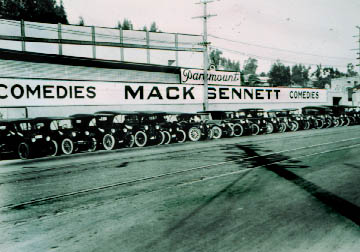
Mack Sennett's Studio
There are plenty of rude comic routines and pratfalls in the Sennett fashion and the film is watchable and enjoyable but no masterpiece. The entire Sennett stock company is present, although almost unrecognizable in walrus mustaches and beards. When originally released as a road show, Yankee Doodle in Berlin went out with several traveling companies of Mack Sennett's Bathing Beauties who performed before and after the screenings in the major cities. The star, Bothwell Browne, also appeared in person in the cities, performing his famed "Oriental Dance." Eventually, the film was cut down to a two-reeler and re-released as "The Kaiser's Last Squeal."
Bothwell Browne was a top female impersonator who toured the vaudeville circuit with flashy and seductive impersonations. He was born in Copenhagen in 1877 and grew up in San Francisco. By the early 1900s he was a local favorite on the San Francisco vaudeville stages. He ran a dance studio, the Bothwell Browne School of Dancing and Stage Culture on Fillmore Street and he also performed at the Grand Opera House. In 1904, at the Central Theater he staged a "Champagne Ballet" and "Persian Scarf Dance" in "Around the World in Eighty Days." In 1905 his troupe, the Gaiety Girls, performed "Mikado, on the Half Shell" at the Chutes Theater. In 1908 he toured with United Vaudeville and performed a series of impersonations that included a Gibson girl, a plantation girl, a suffragette, a showgirl, and a fencing maid (a girl with a sword). He became famous (notorious) for the sensual and erotic quality of his performances. In 1910, he began performing a "Serpent of the Nile" act in which he played Cleopatra. By 1919, the time of Yankee Doodle in Berlin he was at the peak of his career. In addition to his film role as Captain Bob White, he was booked at the Palace Theater and R.F, Keith's Colonial Theater in New York City. When vaudeville finally stopped booking female impersonators, Browne continued his career as a San Francisco dance instructor and lived in the company of his nieces, Dorothy and Flavilla Browne, also well-known dancers. Most vaudeville bookers had female impersonators among their clientele but usually booked them into the rural and smaller vaudeville houses. Female impersonators acts were usually considered too unsophisticated for the major venues in the big cities!
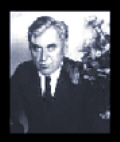
Mack Sennett |
I found my copy of Yankee Doodle in Berlin on eBay. An excerpt is used in the documentary The Moving Picture Boys in the Great War (1975) which is included in World War I Films of the Silent Erafrom Image Entertainment. In 2002, All The Queen's Men starring Matt LeBlanc and Eddie Izzard was released. Its basic plot was the same as Yankee Doodle in Berlin- a group of men must pose as women to steal an Enigma machine from an all-female staffed Berlin factory.
Andrew Melomet, Proprietor of Andy's Nickelodeon will answer your Great War film or video inquiry. He is also soliciting your recommendations for the WWI Filmography he is compiling for our readers. Just click HERE.
|
|
| The following are thanked for their contributions to this issue of the Trip Wire:
Mark Levitch, Christina Holstein, Jim Cooke, Tom Jones, Tony Noyes, Esther MacCallum-Stewart, Andy Melomet, Len Shurtleff. Until next month, your editor, Mike Hanlon. |
|









